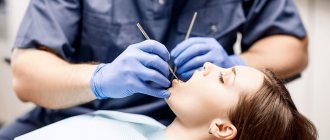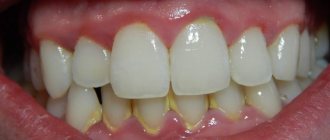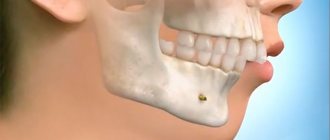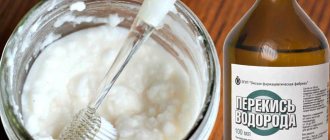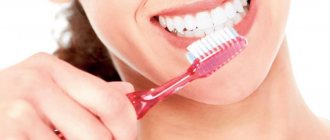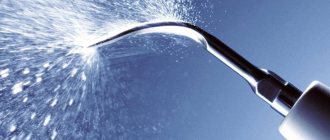- What is tartar
- How is tartar formed?
- Types of Tartar
- Symptoms and consequences of tartar
- How to prevent tartar formation
- Methods for removing tartar
- How is tartar removal performed?
- Removing tartar at home
- Side effects from scaling
- Proper brushing of teeth
- Prices for tartar removal in Moscow
What is tartar and what is the cause of the disease. What methods will help eliminate this aesthetic problem. Is it possible to remove formations without resorting to the help of a dentist?
What is tartar
Tartar is a formation that is a keratinized plaque consisting of poorly removed food debris, calcium, phosphorus and iron salts covered with a biofilm of dead bacteria.
You can find fossilized food deposits over the entire surface of the dentition, but most often the concentration is on the lower incisors, closer to the gums and on the sides.
Please note that tartar can penetrate the back wall and inside the gums. It is usually found in hard-to-reach places where it is impossible to remove food debris with a toothbrush.
Comments
I read that hard plaque can be removed using traditional methods, for example, lemon and radish. What do you think?
Anna (02.12.2018 at 17:53) Reply to comment
- Dear Anna, we invite you to approach this issue intelligently. Lemon and radish are foods high in acids. Hard plaque is the deposition and mineralization of calcium salts. What needs to be done to the teeth so that such hard plaques dissolve by themselves and how long will it take to apply radish and lemon juice to them? This method, at best, will have absolutely no effect on the enamel; at worst, it will disrupt its composition and integrity, corrode, and scratch it. It will also burn the gums and cause an inflammatory process if it gets on the mucous membrane.
Editorial staff of the portal UltraSmile.ru (03.12.2018 at 09:54) Reply to comment
Write your comment Cancel reply
How is tartar formed?
Food particles attach to tooth enamel. Most often from soft and sticky foods, such as flour products.
Under the influence of saliva, a film of glycoproteins is formed; if you do not rinse or brush your teeth, then after 4 hours streptococci bacteria come into play, and actinomycetes join them. After 2 days, streptococci decrease, but the number of anaerobic bacteria increases. After 7 days, spirochetes and motile rods appear.
Remains of food and the bacteria that multiply on them are gradually covered with a film of saliva, smoothed out and hardened. Tartar grows because new layers are added to existing particles.
Fermentation and metabolism processes occur under dental plaque, during which acids are formed. They weaken tooth enamel so that tooth decay can develop over time.
Tartar can also cause bad breath.
Plaque can eventually turn into tartar through mineralization—minerals from saliva are deposited in plaque and make it very hard.
This is how complications arise; as a result of a neglected condition, you can lose a healthy tooth, but ringed with plaque.
The rate of mineralization varies from person to person. It all depends on the following factors:
- the amount of saliva produced;
- its composition and activity of secretions;
- quality of oral hygiene;
- nutritional characteristics;
- violation of salt exchange in the body;
- wearing dental structures (prostheses);
The predominance of solid foods (raw vegetables) significantly reduces the development of plaque. The products act as a cleaning agent, helping to remove dirt from the enamel. Chewing for a long time releases more saliva, which has an antibacterial effect.
Why do stones appear on teeth?
Tartar is hardened plaque that has turned into persistent yellow or brown calcareous formations. Plaque gradually builds up on the surface of the enamel, resulting in the formation of large, hard stones. Most often they form in places that are less involved in the chewing process, on the inner surfaces of the front incisors, as well as in the gum area.
The cause of dental calculus is:
- poor oral hygiene;
- use of low-quality teeth cleaning products;
- eating only soft food;
- chewing food with only one side of the jaw;
- metabolic disease.
Dental calculus is also formed due to the individual characteristics of the composition of saliva. If there are a lot of heavy minerals in saliva, they will definitely precipitate. If the patient has problems with personal hygiene, then this process will develop rapidly.
Stones can be localized on the visible part of the tooth, and can also go deep under the gum tissue. As the stones grow, they move the gums away, as a result of which the tissue no longer adheres so tightly to the enamel. Pathological pockets form under the gums, where food and microbes freely enter.
The deeper the bacterial flora penetrates under the gum, the less oxygen remains there. These places become a hotbed for the development of putrefactive processes. An unpleasant odor appears, the gum structures are destroyed, as well as the bone tissue that holds the tooth in place.
When atrophy reaches half the length of the root, bone anchorage is lost. The ligaments cannot withstand the chewing pressure, and the teeth begin to shift, become curved, and gaps appear between them. You can lose a tooth because it does not stay in the gum.
Types of Tartar
Fossils on enamel come in different types depending on location. So they distinguish:
- supragingival stones – formed on the first molars (lateral) and front or lower teeth;
- subgingival - hard areas that penetrate soft tissue;
- stone bridge – covering the main and adjacent teeth.
Customer Reviews
Veronica: I often buy Dabur paste.
I like its smell and am attracted by the presence of natural ingredients in the composition. For me, the last quality is the most important, since not only my husband and I use the paste, but also our kids. Svetlana:
I've tried a lot of cleansers to clean my teeth. When tartar developed, the dentist advised me to use Albadent. And indeed, it saved me from an unpleasant problem and gave me fresh breath throughout the day. I am very pleased with my choice and now I only buy Albadent.
Angelina: I really like using Detartrin paste. I am satisfied with almost everything about it - composition, price, health safety. The paste clears plaque on enamel, strengthens my gums and eliminates the problem of bleeding gums.
Symptoms and consequences of tartar
Patients experience the following symptoms:
- bad breath;
- bleeding gums;
- caries;
- purulent discharge;
- gingivitis;
- pulpitis;
- periodontitis – inflammation of tissue areas near the root of the tooth;
- mobility and tooth loss.
Gingivitis
The initial form of gum disease.
If left untreated, gingivitis can develop into periodontitis, which is a serious, irreversible gum disease and the most common cause of tooth loss in adults.
The main 4 signs of gingivitis:
- Bleeding gums. Healthy gums do not bleed. If blood comes out when using a toothbrush or floss, this may indicate the onset of gingivitis. Even if it happens from time to time. The symptom should not be ignored as it may be a sign of the onset of gum disease.
- Unpleasant smell. There are many reasons for a bad odor: specific foods, poor hygiene, but it can also be the first sign of gingivitis. This is due to the fact that the bacteria that cause gum disease produce an unpleasant odor by breaking down food particles in the mouth.
- Swollen gums. They are usually pink and firm. Redness and swelling may indicate the onset of the disease.
- Receding gums. They begin to separate, and the root of the tooth is exposed, the incisors appear longer. Increased sensitivity is another sign.
A common cause of toothache is inflammation of the dental nerve, called pulpitis. Anyone suffering from this should seek help from a dentist as soon as possible.
Pulpitis
In acute pulpitis, pain usually occurs spontaneously. The pain may be constant or occur periodically. In rare cases, the inflammatory process is completely painless.
If the affected tooth is sensitive to pressure and impact, this is a sign of a dead dental nerve. It hurts when you touch the tongue, but especially when you squeeze it. The pain is often worse at night, as the warmth of the bed increases the inflammatory process. If left untreated, bacteria from the medullary cavity of the tooth can penetrate through the hole at the root tip into the surrounding bone and soft tissue. Accordingly, inflammation spreads, the cheek and lymph nodes swell.
Periodontitis
Periodontal disease is defined as chronic inflammatory disease of the gums. It is mainly caused by bacterial plaque (biofilm, plaque), especially in old age.
As a result of inflammation, your teeth may hurt and your gums may bleed more easily. If left untreated, periodontitis can also lead to tooth loss.
Patients with periodontitis usually show few symptoms at first. However, some signs may indicate the disease:
- bleeding gums;
- red and swollen gums;
- Gum recession;
- open and sensitive necks of teeth;
- putrid odor from the mouth;
- unpleasant taste, especially when pus leaks from the inflamed areas;
- The spaces between the teeth widen;
- loose teeth, misaligned teeth.
Preventing deposits
Instead of thinking about how to get rid of plaque at home when you find it on your teeth, it is better to take care of following preventive recommendations. Preventive action:
- Regular oral hygiene. Systematic cleaning with paste and brush at least 2 times a day, morning and evening, is important.
- Using additional cleansers after meals and snacks throughout the day. These can be threads (floss), an irrigator, a rinse aid, or a special brush.
- Minimizing the consumption of tea, coffee and other coloring drinks and foods.
- Getting rid of bad habits, this especially applies to smoking.
- Introducing hard vegetables and fruits into the diet to naturally cleanse the enamel during chewing.
- Periodic examinations by a dentist (at least once every six months).
- Refusal of confectionery, baked goods, soda.
- Replace the brush every 2-3 months.
Several conclusions can be drawn about how to remove plaque: cleaning at home does not always show high effectiveness, especially if the deposits appeared a long time ago and have hardened. Professional procedures are effective and take place very quickly, but require additional time and financial costs.
To prevent such problems from occurring, it is necessary to adhere to the rules of prevention. First of all, high-quality oral hygiene is extremely important, in the absence of which colonies of pathogenic microorganisms will settle on hard and soft tissues in the mouth, whose vital activity leads to unpleasant consequences for the human body.
How to prevent tartar formation
By observing good oral hygiene, you can prevent the (re)formation of tartar:
- Brush your teeth thoroughly at least twice a day using a good manual or electric toothbrush and fluoridated toothpaste.
- Clean between teeth once a day using dental floss or interdental brushes.
- With these measures it is possible to prevent the formation of plaque and therefore tartar, as well as to prevent tooth discoloration and decay.
Pastes for removing plaque and polishing teeth –
To remove small tartar and pigmented plaque, we can use 2 groups of products. Firstly, there are some whitening toothpastes that are highly abrasive. The second option is that you can purchase a special paste for polishing teeth in a specialized store that sells consumables for dental clinics (this option is much more effective, and you can even place an order online).
The advantage of the first option is the high availability of whitening toothpastes (list below), but their capabilities will be much more modest when compared with professional polishing paste for removing plaque and plaque. Below we will talk in more detail about each option.
Detartrine Z polishing paste –
Professional polishing pastes “Detartrin” and “Detartrin Z” do an excellent job not only of smoker’s pigment plaque, but also even of small dental deposits. The second version of this paste is especially effective, containing specially sharpened zirconium granules that can remove dental plaque and smoker’s plaque without damaging the enamel (24stoma.ru). In addition, the paste contains essential oils, leaving a long-lasting feeling of freshness in the mouth. Production – (France).
Pastes “Detartrine” and “Detartrine Z” –
The paste is taken from the tube only with a clean spatula and applied to the bristles of the working head of the Oral-b brush. Next, you need to “spread” the paste over several teeth, then turn the brush on at low speed, and treat each tooth for 10-20 seconds (more precisely, as needed). After treating your teeth, you need to rinse your mouth thoroughly several times. Use no more than once a week. The cost of a 45 mg tube of “Detartrine Z” in different stores can range from 1,600 to 2,800 rubles.
There is also another version of this paste - the usual “Detartrine” without zircon. It is a little cheaper, but also copes somewhat worse with, for example, the smoker’s residue. But in any case, both versions of this paste are much more effective at removing pigmented plaque and dental plaque than most other similar products (i.e. similar polishing pastes from other manufacturers).
Toothpaste “PRESIDENT PROFI PLUS White Plus” –
controlled abrasiveness – RDA 200 ,- abrasive and polishing components (silicon dioxide, calcium carbonate, diatomaceous earth, titanium dioxide),
- applied only once a week,
- price 30 ml - about 260 rubles.
It is necessary to apply a small amount of paste to a group of several teeth, and then use the Oral-b toothbrush at low speed, for example, in the “Whitening / Polishing” or “For Sensitive Teeth” modes. The effectiveness of PRESIDENT White Plus will be lower than Detartrine Z.
Toothpaste “LACALUT White” –
controlled abrasiveness – RDA 120 ,- abrasive and polishing components (hydrated silicon dioxide and titanium dioxide),
- benefits – contains pyrophosphates and sodium fluoride,
- fluoride content: 1357 ppm,
- together with an electric brush can be used once every 2 days,
- price: 50 ml – from 250 rub., 75 ml – 350 rub.
The effectiveness of this paste will be significantly lower than the previous ones. And she can only help you with a small amount of not too pronounced pigmentation. Apply according to the same principle as previous products (together with an Oral-B electric brush).
A few additional recommendations -
The cost of a good Oral-B electric brush starts from 2700-3500 rubles (at this link you can read our review on the optimal choice of models). You can even buy “Detartrine Z” or “Detartrine” polishing paste in traditional online stores, but it will be cheaper to do it in those organizations that sell consumables for dental clinics. There are many such companies in every city. And I would like to say a few more words about the selection of toothpaste for daily use in the morning and evening.
It is advisable that in patients with a high rate of tartar formation, such a paste contains polydon or pyrophosphates (these components significantly reduce the rate of mineralization of soft microbial plaque and its transformation into hard tartar). Polyphosphates (for example, sodium hexametaphosphate and trisodium phosphate) can significantly reduce the adhesion and deposition of microbial plaque.
Another useful components are the proteolytic enzymes bromelain and papain. They help loosen the already formed tightly attached microbial plaque, which certainly contributes to its removal by the abrasive components of toothpastes. In addition, it is desirable to contain sodium fluoride or amino fluoride in the paste, and in a concentration of at least 1400 ppm. The fact is that fluoride has a bactericidal effect, suppressing the vital activity of microorganisms, thereby preventing an increase in the volume of microbial plaque in the oral cavity.
Well, in the next section we gave several examples of techniques that are recommended for removing tartar at home - on various thematic sites and forums. You might be interested in reading this nonsense.
Methods for removing tartar
- Physical method. Consists of mechanical destruction of deposits using a dental instrument with a thin tip. Modern medicine uses the Air flow system. Fine particles of soda are applied under high pressure, causing a stream of air containing the powder to knock the fossils off the tooth. A subsequent stream of water washes away the separated particles.
- Chemical method. Allows you to remove formations with the help of compounds that dissolve the basis of tartar - deposits of mineral salts. A composition is applied to the teeth that softens plaque, but does not cause significant harm to the enamel. Then the impurities are removed.
- Ultrasound. Ultrasonic waves do not injure teeth and gums. Contraindicated in patients using a pacemaker.
- Laser. The laser method can be used specifically in dentistry for various procedures. It is one of the most effective and expensive procedures. The laser beam is very thin and can be used precisely. This way, only truly unwanted tissue is destroyed. Healthy tissues are preserved. Local anesthesia is often not required. Laser treatment does not cause noise or vibration like drilling. The virtually painless treatment is especially suitable for anxious patients.
LACALUT Basic and White
To achieve maximum effect, the manufacturer suggests combining these two pastes. Basic use in the morning. It contains turmeric components that slow down the rate of formation of hard plaque, eliminate pathogenic microflora and get rid of unpleasant odor. The product also provides comprehensive gum care and has an anti-inflammatory effect due to the aluminum lactate it contains.
But it is better to use the White product in the evening to remove plaque, because the number of abrasives (120 RDA) allows this to be done. But, as the manufacturer assures, they do not injure or scratch the enamel, because... the grains are spherical in shape. Pyrophosphates in the composition also prevent the appearance of tartar. The cost of “Lakalyut basic” is from 270 rubles, “Lakalyut white” is 280 rubles.
How is tartar removal performed?
At the first stage, the presence or absence of allergies in the patient to drugs will be determined.
Then the degree of sensitivity of the teeth is determined, and an anesthetic is applied as necessary.
The method by which the procedure will be carried out is selected.
For rough tartar removal, an ultrasonic scaler is often used first. This is followed by processing with special hand tools to remove stubborn dirt.
The enamel is cleaned of residual particles of contamination and the doctor begins to polish the teeth so that the surface is completely smooth.
Small irregularities and areas of rougher texture on the teeth are also smoothed out, providing protection against further plaque buildup.
The enamel of the teeth is coated with varnish.
After the work has been done, the dentist will advise how often you should plan to remove tartar.
It should be noted that professional cleaning is only intended to be an addition to daily thorough oral hygiene and should in no way be considered a replacement for brushing your teeth twice daily with fluoride toothpaste.
Some tips for choosing the right paste
- Products with several active ingredients work well.
- You can give preference to a paste that both removes film and prevents the formation of solid deposits to be on the safe side.
- It’s not bad when natural ingredients are included in the product. The substances will promote healing and maintain overall oral health.
- The components of an ideal toothpaste may include vitamin complexes, panthenol, alloin, and minerals. For the same reason as in the previous paragraph.
Removing tartar at home
Home remedies for tartar can be useful for removing soft plaque without the help of a dentist.
If there is already a hard coating, then you should definitely seek treatment from a specialist. Trying to pick out deposits on your own will not work. As a result, the enamel will only be damaged. It cannot be restored.
- Vinegar and lemon. The acid contained in vinegar and lemon acts against tartar. However, the taste is unpleasant, and the acid has an aggressive effect on tooth enamel. These home remedies should be used no more than once a month.
- Baking powder. The crystals found in baking powder and baking soda act like sandpaper and remove unwanted coating. Dip your fingertip in baking soda and vigorously rub the affected areas. However, the powder can potentially damage healthy gums and tooth enamel.
- Tea tree oil. Rinse your teeth thoroughly with a solution of 1-2 drops in a glass of warm water.
- Xylitol. Xylitol is a sugar substitute and, as an ingredient in chewing gum, can support oral hygiene. Research shows that xylitol is beneficial for dental health.
- Tincture of myrrh. Has a preventive effect. Brush sensitive areas along the gum line to reduce acid buildup. The liquid is also used for gum inflammation caused by tartar or its removal.
- Coconut oil and olive oil. Take one or two tablespoons of natural oil into your mouth and thoroughly rub the liquid between your teeth for several minutes. You must be careful not to swallow it and then rinse your mouth thoroughly with clean water.
- Sesame seeds. Chewing sesame seeds vigorously provides the body with healthy fats and also helps against the formation of tartar. Apply the well-fertilized seed paste several times to the affected areas of the teeth, using your tongue as a tool to create the necessary friction for grinding.
- Celandine. A good remedy not only for skin diseases, but also helps cleanse teeth of plaque. Prepare a decoction and rinse your mouth without swallowing. The plant contains toxins that can harm the stomach.
- A mixture of lemon juice and black radish. Suitable for treatment and preventive measures. Apply to teeth, then rinse with warm water. You cannot clean with a brush after acidic juice, because it softens not only the stones, but also the enamel. You need to wait 30 minutes.
- Decoction of burdock and green beans. Burdock can be picked locally or purchased dry crushed leaves at the pharmacy. The combination of these plants will help soften the stratum corneum.
- Dental floss. You can use it to thoroughly and permanently clean hard-to-reach spaces between teeth.
Forewarned is forearmed: what are the reasons for the appearance of an old plaque
Let us repeat once again that not a single anti-tartar paste will help if you constantly violate the hygiene regime, and also give preference to soft, carbohydrate-rich, sweet foods, carbonated drinks, and alcohol. All these products release acids, which, settling on our enamel with food debris, produce the development of bacterial microflora. In addition, soft food weanes the teeth from the natural load, sticks to them and clearly does not contribute to the natural removal of plaque, but only aggravates its appearance.
It is interesting that sugar, as an accessible and cheap mass-produced product, became popular only in the late 19th and early 20th centuries. But in ancient times in Egypt and Rome, for a very long time, only the rich could treat themselves to it - and it was among them that caries was first identified1.
Smoking also contributes to the formation of mineralized plaque. Obvious deposits are especially noticeable in those who have had this bad habit for a long time. The quality of oral cleansing is also of great importance. For example, dental experts claim that a classic toothbrush only copes 50% with its main responsibilities and removes deposits. But electric or ultrasonic removes up to 95% of all plaque. They should also use floss and irrigator, as well as a special toothpaste that removes tartar.
Smoking can cause plaque
Side effects from scaling
These effects can appear after professional removal and when using folk remedies.
- Uncomfortable sensitivity from ultrasound: Some patients are sensitive to pain from ultrasound because the dental nerve or gums may be irritated. In addition, some people are bothered by accompanying sounds.
- Temperature Sensitivity: Once plaque is removed, teeth may be more sensitive to stimuli such as cold or heat. This is because tartar protects the tooth from these irritants. After removal, he first needs to get used to the intensity of the stimuli.
- Loose teeth: If you begin to notice loose teeth after tartar removal, especially the incisors, this may be a sign of periodontitis, which was previously unrecognized because the tartar was holding the teeth together. Depending on the severity of periodontitis, the dentist treats the bacterial infection of the periodontium with medications.
"Liquum-gel" from SPLAT
The manufacturer is very careful about this toothpaste. He emphasizes that it works against tartar, i.e. prevents its formation due to natural papaya derivatives and a high-molecular polishing system.
It turns out that if you already have hard dental deposits, then it will not remove them, but if you had professional hygiene at the dentist, and now you are maintaining the result, then it will help in this difficult task and will cope with its mission with a bang. Studies have also proven that within four weeks of use, the composition can lighten the enamel by one shade, which is also very pleasant. Plus, due to bioactive calcium, the enamel will strengthen and its sensitivity will decrease. The asking price is from 155 rubles2.
Proper brushing of teeth to remove plaque
Bass technique has been developed to remove food debris from the gum area. It is performed according to the following algorithm:
- Apply paste to brush
- Rinse your mouth with water
- Position the brush parallel to the teeth
- Slightly tilt the brush approximately 45 degrees.
- Move the device without pressing
- Then move in a circle, trying to get the bristles between the teeth
- Go over the entire jaw 15-20 times
- Move in a circular motion along the side teeth
- Do not ignore your tongue; 80% of pollution accumulates on it.
- Remove plaque from tongue
- There are brushes with a rough or bumpy back wall, specially made for cleaning this organ.
- After the outer part is completed, it is necessary to move on to the back wall of the incisors and molars. To do this, the brush is placed vertically with its bristles.
- It is recommended to carry out the procedure near a mirror to see the correctness of your actions.
As you can see, problems in the oral cavity and teeth occur in most cases due to non-compliance with hygiene rules.
Residues of food and the accumulation of bacteria on them create a plaque that hardens over time and cannot be removed by regular cleaning.
This is not only an aesthetic defect, but also serves as the basis for the development of dangerous diseases.
Brushing your teeth twice a day and regular dental check-ups will help reduce the risk of formations.
How do you choose what to look at?
When choosing the best paste, you should take into account a number of factors, namely:
- Most toothpastes contain an abrasive substance that has a negative effect on the enamel surface.
safety of the components included in the composition;
- manufacturer reliability;
- product quality;
- reviews about the chosen product.
Not all toothpaste is safe.
Most of them contain an abrasive substance that has a negative effect on the enamel surface.
A good enamel cleaning paste usually includes:
- Fluorine (fluorides), which are useful components. Their level should be 0.1-0.6%.
- Calcium carbonate is an abrasive substance that effectively cleans the enamel surface of bactericidal deposits.
Important! The paste cannot contain both fluorine and calcium carbonate, since their combination will lead to the destruction of the enamel. - The RDA level allows you to find out the amount of abrasive in the composition. When choosing, you should take into account the sensitivity of the teeth and the intensity of the appearance of new deposits. The higher the RDA, the more effectively the paste will cope with crystallized deposits. However, with sensitive enamel, the RDA level should not exceed 25 units!
- SLS is the ingredient responsible for the degree of foaminess. It is a mistaken belief that the most effective product is the one that foams well. High-quality pastes do not contain SLS in their composition, as it is harmful to the body.
- Triclosan is an antibacterial substance that can act as an antibiotic. This drug destroys harmful bacteria along with beneficial substances. In this situation, the microflora of the oral cavity suffers, which leads to the occurrence of various diseases.
Prices for tartar removal in Moscow
| Removal of dental plaque (1 tooth) | 150 rub. |
| Ultrasonic cleaning (1 jaw) | 2000 rub. |
| Comprehensive professional preventive oral hygiene (including ultrasonic cleaning, Air Flow, polishing and fluoridation) | 5500 rub. |
| Polishing 1 tooth with abrasive paste | 500 rub. |
| Local enrichment of the 1st tooth with fluoride | 300 rub. |
| Fluoridation (1 jaw) | 2000 rub. |
| Air-flow (1 tooth) | 250 rub. |
| Air-flow (1 jaw) | 2000 rub. |

